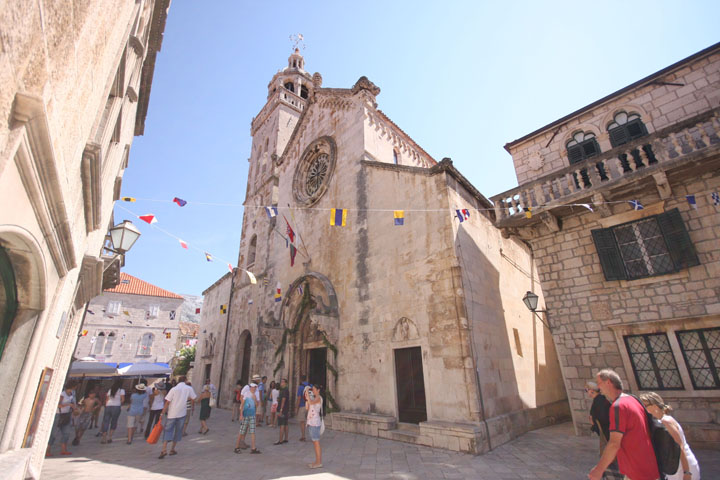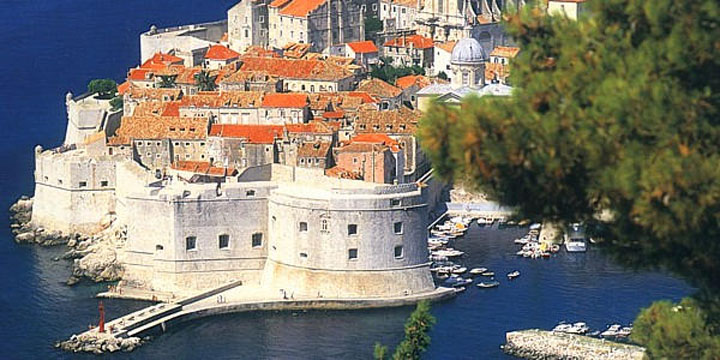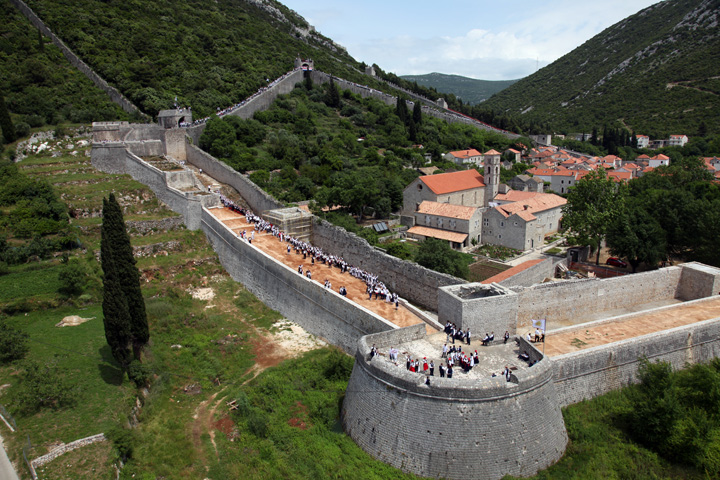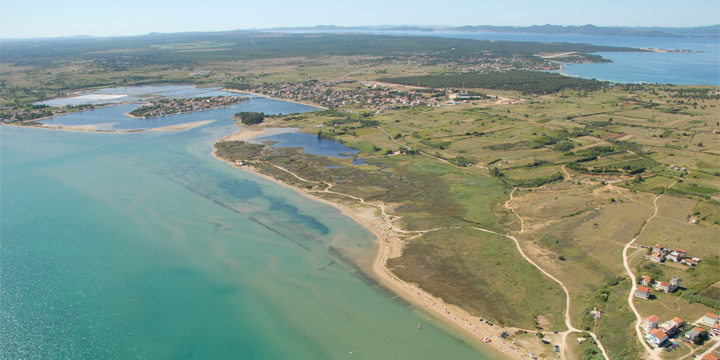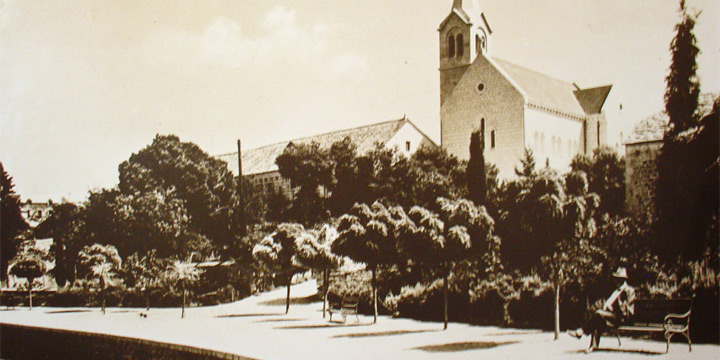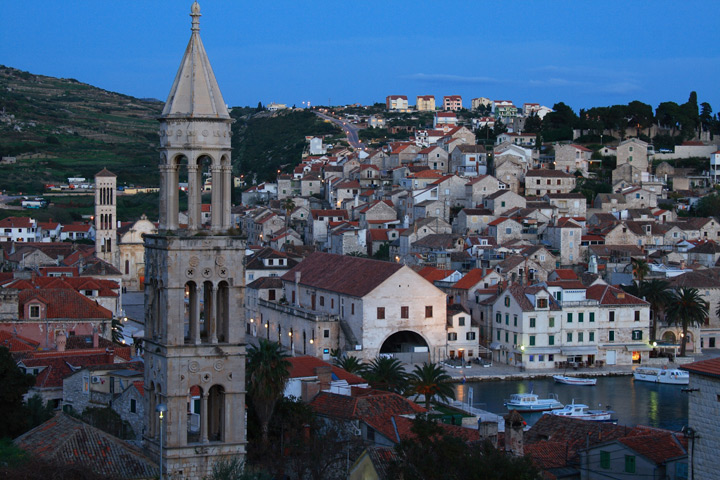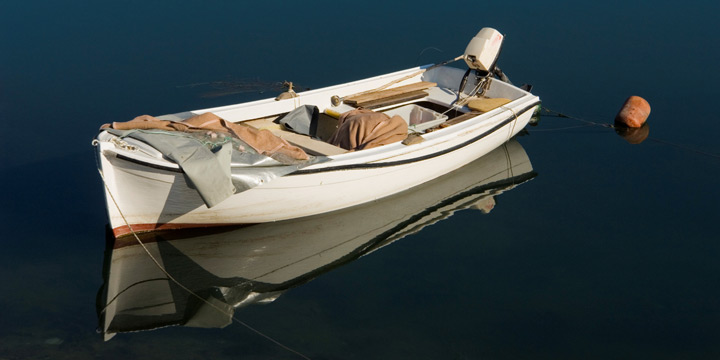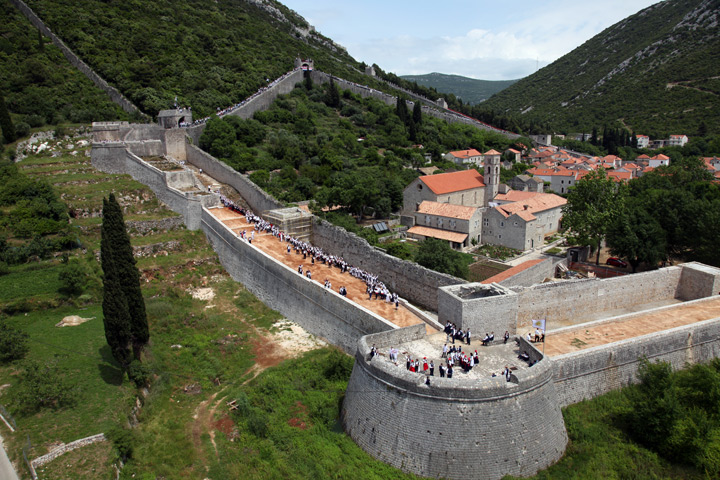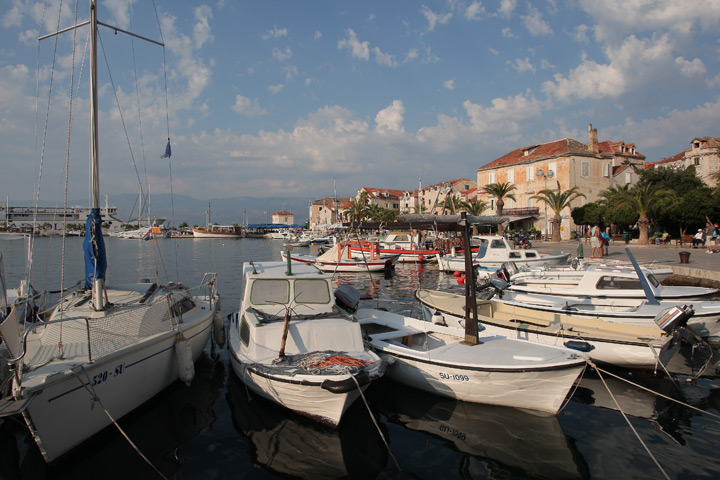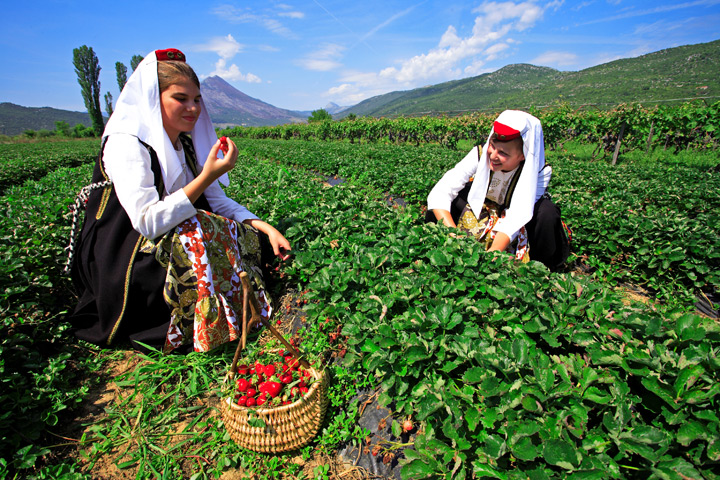The town of Korčula - stone pearl surrounded by blue expanses
The town of Korčula is located on the northeastern part of the island, whose lavish flora was noticed and recognized even in old times, so ancient Greeks named it Korkyra Melaina. Encouraged by preciousness of monumental and cultural heritage of this city, as well as by uniqueness of its architectural design, we rightly call it a stone pearl!
Lovers of cultural sights will discover an inexhaustible source, due to its magnificent visual identity in the late Gothic and Renaissance style. We recommend visiting the brightest testimony of architectural virtuosity - St. Mark’s Cathedral, and as a special attraction, the fantastic Marco Polo Museum, where seven memorable scenes from the life of the Korčula’s most famous citizen are evoked in a superb setting and with accompaniment of an audio guide. Exactly this town is the birthplace of the world’s famous traveler, merchant and explorer who lived in the 13th century, and wrote third most read book in the world – “The Million”, in which he recorded knowledge and skills acquired during his 17-year stay in the Far East.
Other than tangible heritage, the richness of Korčula’s tradition is shown by unique performances of cultural associations that nurture secular knight games – Moreška, Kumpanija and Moštra. The city boasts a large number of events – from harmony singing groups’ meetings, to Korkyra Baroque Festival, an international level event.
Korčula is also proud of delightful cuisine, especially when it comes to excellent white wines with specific aromas (Grk and Pošip). Pair them with fish prepared in a variety of ways, seasoned with fine olive oil. From different types of meat, locals preferably prepare lamb, which enjoys the same status of a specialty as the delicious homemade smoked ham and cheese. There is also a broad range of traditional sweets, so make sure to try hrustule, cukarini and klašuni filled with walnuts, quince jelly – kotonjata…
For a pleasant stay in the town of Korčula, at your disposal are comfortable hotels and private accommodation facilities, sea camps and ACI marina. With a wide range of its own offerings, the town also offers the possibility of various excursions.
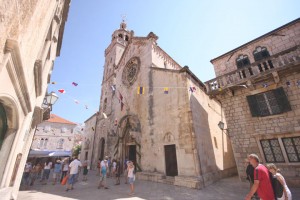 [nivo effect="fade" directionNav="button" controlNav="true" width="720px" height="360px"]
[nivo effect="fade" directionNav="button" controlNav="true" width="720px" height="360px"]
[image]http://hotspots.net.hr/wp-content/uploads/2013/01/korčula.jpg[/image]
[/nivo]
Weekend destination for the bishops of Korčula and nobility
Lumbarda is a small place located on the eastern cape of the forested island Korčula, with 1200 inhabitants, lively untouched scenery, rugged coastline, crystal clear sea, sandy beaches, rich history preserved in documents dating back over two millenniums, olive trees, quality wines, preserved customs and traditions, gastronomic specialties of local cuisine...but above all – hospitable hosts.
In history, Lumbarda was [nivo effect="fade" directionNav="button" controlNav="true" width="720px" height="360px"]
[image caption="Foto: Turistička zajednica općine Lumbarda"]http://hotspots.net.hr/wp-content/uploads/2013/01/03.jpg[/image]
[image caption="Foto: Turistička zajednica općine Lumbarda"]http://hotspots.net.hr/wp-content/uploads/2013/01/Lumbarda.jpg[/image]
[/nivo]
, and even today it has preserved the same feeling. It is easily reached from six kilometers distance from Korčula. It is an ideal destination for guests looking for quiet, safe and unique vacation.
Sandy beaches and archipelago of about twenty islets are in the vicinity of this place. The scenery abounds in Mediterranean aromatic herbs, pine trees, salt, all coloured with different shades of blue, sand and stone white, pine green and agave silver green.
The guest will enjoy „Lumbarajske užance“, manifestations and events related to customs, dances, songs, trade, artists, food and wine, performed by local people who will make your evenings in Lumbarda an unforgettable experience.
1. GASTRO
Lumbarda offers a variety of restaurants, taverns and rural households with traditional meals and rich selection of wine from the gardens of Lumbarda.
WINE
The island of Korčula is famous for its white wines. „Grk“ is the type grown in Lumbarda, „Pošip“ and „Rukatac“ in the central part of the island. Widely known red wine is „Plavac mali“.
GRK- Lumbarda is famous for this quality wine made of the local type of grapes of the same name. It can only be grown in sandy vineyards of the fields in Lumbarda. It is not known whether it got the name for its sophisticated bitter taste or it was named after the Greeks that founded their colony here at the beginning of the 3rd century B.C. Stone inscription Lumbarda Psephism, monument from that area, talks about this settlement and „the soil for planting grapes“', proving that vineyards date back to 2300 years.
„Grk“ goes perfectly with sea food, but quality white meat as well, and it can always be served as an aperitif.
DUBROVNIK – CULTURAL MUSEUM IN THE OPEN
Make sure to begin your visit to Dubrovnik with a promenade in Stradun or Placa while getting the first impressions of one of the most beautiful cities of the Mediterranean. The astonishing city of stone is surrounded with 1,940 m long walls. A tour of the world's second most frequented open-air museum will definitely take your breath away.
Visit the museums of Dubrovnik and find out where the rector of the glorious Dubrovnik Republic used to live, where grain was stored, which sailing ships formed parts of the powerful Dubrovnik Republic fleet travelling around the world, making Dubrovnik famous.
Taste some of the delicious Mediterranean specialities at the taverns and restaurants of the Old City and complete the treat with a cup of coffee in Stradun.
Buy some of the typical Dubrovnik souvenirs (delicacies, traditional filigree jewellery, a bronze statuette of St. Blaise, Konavle embroidery…) to remind you of the day when you began to discover Dubrovnik and inevitably fell in love with it forever, wishing to come back…
Walk the city walls, and make sure to visit the Maritime Museum in order to learn about the centuries-long seafaring tradition of the Dubrovnik Republic. Discover more about the famed seamen, and the mathematician Getaldić and the physicist Ruđer Bošković who calculated the loading capacity of the merchant ships karaka, galijun and nava. Take a ride by cable car up to the top of Srđ. The ride offers breathtaking view of the Old town of Dubrovnik, stunning coastal sights and magnificent sunsets. Take your time, and enjoy the view you will remeber for a long time!
[nivo effect="fade" directionNav="button" controlNav="true" width="720px" height="360px"]
[image caption="Foto: Turistička zajednica grada Dubrovnika"]http://hotspots.net.hr/wp-content/uploads/2013/01/dubrovnik_sightseeing1.jpg[/image]
[/nivo]
Tourist tradition of Dubrovnik - Neretva County
Dubrovnik-Neretva County has for centuries attracted many visitors. In the beginning they were mostly traders from the interior and neighboring countries - diplomats, pilgrims, explorers, travelers. Nowadays this area is a favorite destination for guests who want a tour of magnificent antiques, as well as nature lovers and active vacationers, among which everyone will surely find something for themselves.
Let's start from the lovers of nature, to whom we recommend a visit to National Park of Mljet, one of the most beautiful Adriatic islands with two deep bays called lakes due to the very narrow links to the open sea, and lush and diversified Mediterranean vegetation. Mljet is also proud of the rich cultural heritage, and the most impressive example is the complex of the Benedictine monastery from the 12th century.
We should mention the special nature reserves - the southeastern part of the Neretva River delta, the habitat of many fish species and of rare species of birds. This site is visually appealing and easily accessible thanks to the existence of the road to the river mouth. Then, the Mali Ston Bay, which is a well-known mussel farm and gastronomic center of the County, famous for particular geological features and natural flow of nutrient salts. We should also highlight the islet of Lokrum near Dubrovnik, which boasts Holm oak trees and Maquis with Aleppo pine.
The fans of sightseeing will not be disappointed - we recommend a tour of the medieval town of Cavtat built by the Dubrovnik principles of harmony, marked by valuable works from all historical periods. Visit Trsteno, the oldest arranged Renaissance Park in Dalmatia rich in exotic plants, and beautiful Gothic Renaissance monument in the town of Korčula - St. Mark’s Cathedral, whose altars are decorated with many paintings by Jacopo Tintoretto and the other Italian artists.
And for active holiday enthusiasts, this region also has a lot to offer. Domestic and foreign nationals may engage in recreational and sport fishing, and guests can enjoy a unique diving experience. Numerous hiking trails reveal the unspoiled nature, and for those who are a bit more demanding, we recommend visiting geomorphologic monuments – a number of interesting caves!
Finally, we should not forget the gourmet-minded visitors. In the Neretva Valley you can try eel or frog stew, delicious wild animal meals, particularly a wild duck (coot). From there the road leads us to Ston, where you may try oysters, mussels, and freshly made fish. On the islands of Mljet, Šipan, Lopud and Koločep you can enjoy delicious dishes of dried fish or seafood in restaurants and taverns, and in Dubrovnik and Župa Konavle you will be offered with prosciutto, cheese in olive oil, green pasta and other delicacies.
Nin – the oldest Croatian royal city
[nivo effect="fade" directionNav="button" controlNav="true" width="720px" height="360px"]
[image caption="Nin, krunidbena crkva Sv. Nikole 11-12.st"]http://hotspots.net.hr/wp-content/uploads/2012/05/Krunidbena-crkva-sv-Nikole-11-12.st_.jpg[/image]
[image caption="Nin, Crkva Sv. Kriza"]http://hotspots.net.hr/wp-content/uploads/2012/05/Nin_Crkva-sv.-Kriza.jpg[/image]
[image caption="Kraljičina plaža, Nin u pozadini i turističko naselje Zaton"]http://hotspots.net.hr/wp-content/uploads/2012/05/Kraljicina-plaza-Nin-u-pozadini-i-turisticko-naselje-Zaton.jpg[/image]
[image caption="Brda soli i spakirana sol"]http://hotspots.net.hr/wp-content/uploads/2012/05/Brda-soli-i-spakirana-sol.jpg[/image]
[image caption="Cvjetna sol"]http://hotspots.net.hr/wp-content/uploads/2012/05/Cvjetna-sol.jpg[/image]
[/nivo]
History with a taste of salt
The first capital of the Croatian kings from the 9th century, except for its rich cultural heritage - which includes the smallest cathedral in the world - provides you with health and tourism, as well as enjoying the traditional method of salt production, back to Roman era.
According to many, all the secrets of the Croatian people are hidden in the walls of Nin, a town just 14 km away from Zadar.
It is the oldest Croatian royal town and the first capital of the Croatian kings from the 9th century. Located on an island of only 500 meters in diameter, connected to the mainland by two centuries-old stone bridges, it witnessed many historic events. Enjoy the return to the past with well-preserved monuments of culture - from the old Croatian churches built between the 9th and 12th century, to the Church of St. Cross known as the smallest cathedral in the world. Take a look and the Museum of Nin Antiquities and original Croatian wooden ships from the 11th century (Condura Croatica).
But Nin is not only a historic town - due to the medicinal mud which lies at the western part of the Nin Bay, it is also proud of its health tourism. The Medical Center of Zadar has been using Peloid mud for 40 years, to treat rheumatic diseases, spinal problems and skin disorders, while the unique geographical position of a lagoon offers ideal weather conditions to relieve respiratory issues.
Nin thus provides the ideal conditions for relaxation (the habitat of various species of birds, beautiful long sandy beaches and preserved nature) and recreation (surfing due to the wind and breeze), enjoyment of cultural heritage, but also a unique museum, the first of its kind in our country - The Salt Museum.
Namely, the Nin people still produce salt in the traditional way, so in the area of the present salt pans, you'll find the remains of a Roman stone slab used for the removal of sea water. Nowadays the salt is collected in the same way, and particularly valuable is the flower salt, enriched with magnesium and calcium.
Therefore Nin is a must-see place - just select one of the events that are on offer: pilgrimage of Our Lady of Zečevo, "Nin - the oldest Croatian royal town" project, the Croatian Crown play, the Ninski Šokol Festival, “The Journey of Petar Zoranić of Nin” project, and the manifestation The Days of Salt in Royal Nin, Festival of The Sun, the lights in the Church of St. Cross and others.
In Nin you will discover a myriad of reasons for pleasure: from sightseeing of cultural heritage scattered throughout the historical core of Nin to unique events, and especially to the enjoyment of natural wonders of Nin: salt, healing mud, magical sandy beaches and a rich birdlife.
TURISTIČKA ZAJEDNICA GRADA NINA
TRG BRAĆE RADIĆA 3
23232 Nin
[styled_link link="http://www.nin.hr" variation="slategrey"]www.nin.hr[/styled_link]
Municipality of Selca - Dalmatian Sleeping Beauty
[nivo effect="fade" directionNav="button" controlNav="true" width="720px" height="360px"]
[image caption="Sumartin"]http://hotspots.net.hr/wp-content/uploads/2012/05/Sumartin.jpg[/image]
[image caption="Selca Sumartin, panorama"]http://hotspots.net.hr/wp-content/uploads/2012/05/Selca-Sumartin-panorama.jpg[/image]
[image caption="Selca, pjaca"]http://hotspots.net.hr/wp-content/uploads/2012/05/Selca-pjaca.jpg[/image]
[image caption="Povlja, panorama"]http://hotspots.net.hr/wp-content/uploads/2012/05/Povlja-panorama.jpg[/image]
[image caption="Panorama Sumartin"]http://hotspots.net.hr/wp-content/uploads/2012/05/Panorama-Sumartin.jpg[/image]
[/nivo]
The Municipality of Selca lies 36 km from the capital of Supetar and 26 km from Bol, and there's also a car ferry to Makarska. Due to its excellent transport links and the possibility of safe anchoring of marine vehicles, it is a place of an extreme nautical importance. For the lovers of magnificent coupling of crystal-clear sea and untouched nature, the municipality has prepared a total of 1400 beds in private accommodation. Rich cultural heritage and homemade delicacies will meet the expectations of even the most demanding guests.
This string of 5 Dalmatian pearls is proud of three coastal locations (Povlja, Sumartin and Selca-Puntinak), and two places on the hill (Novo Selo, the Municipal Center of Selca).
Great tourism tradition has been ongoing since the establishment of the first tourist association in Povlja (1931). Povlja, as well as Sumartin, with a new nautical port with 30 berths and nautical pump nearby, are both safe anchorages for ships - they offer secluded sandy beaches and countless hidden bays ideal for visitors in search of true peace and rest. The lovers of sightseeing will also come into their own, due to numerous sacral and monumental objects and items - from the oldest preserved document written in Croatian Cyrillic (the Povlja Charter and the Povlja Treshold), found in the well-preserved 6th century Christian basilica and in Benedictine monastery; to the local parish church in Selca, a neo-Gothic style building which, for its monumental splendor and beauty, carries the title of the Cathedral of Brač. Selca, intrinsically connected to the stone-masonry and architecture of white stone from Brač, have a number of important sculptures, among others a monument to Tolstoy from 1911, and statues of famous Croatian artists Meštrović and Augustinčić.
When Selca’s guests get pleasantly tired from the sun, sea, sightseeing or a 70 km walks through the pristine nature, it is time for homemade specialties: enjoy the original natural products of high quality: seafood and fish, lamb, figs, herbs, with a drop of homemade wine and oil!
Tourist board Selca
[styled_link link="http://www.touristboard-selca.com" variation="slategrey"]www.touristboard-selca.com[/styled_link]
[styled_link link="http://www.selca.hr" variation="slategrey"]www.selca.hr[/styled_link]
Hot Spots destination 2012 - city of Hvar
[nivo effect="fade" directionNav="button" controlNav="true" width="720px" height="360px"]
[image caption="Hvarsko kazalište"]http://hotspots.net.hr/wp-content/uploads/2012/04/Hvar-kazaliste.jpg[/image]
[image caption="Hvar by night"]http://hotspots.net.hr/wp-content/uploads/2012/04/Hvar-by-Night.jpg[/image]
[image caption="Hvar"]http://hotspots.net.hr/wp-content/uploads/2012/04/Hvar_1.jpg[/image]
[image caption="Hvar"]http://hotspots.net.hr/wp-content/uploads/2012/04/Hvar-by-Night_2.jpg[/image]
[/nivo]
Hvar is something really special
Hvar is wonderful and remarkable in everything.
It boasts one of the most beautiful Mediterranean landscapes Nature has ever created, an agreeable and healthy climate, a clean, unpolluted environment, the strong and intoxicating fragrance of lavender, rosemary and heather, cheerful and brisk everyday life, age old and glorious history, illustrious Renaissance poets, the first public theatre in Europe, an attractive urban visage (some have likened it to a woman's face), a rich variety of cultural and historic monuments, the longest tradition of organised tourism in Croatia,
witty and charming hosts and their immeasurable love for their town, and a magical power to charme and enslave anyone who ever steps on its soil.
How can it be explained?
Hvar is something really special, an experience you mustn't miss!
Text: Marinko Petrić
Turistička zajednica grada Hvara
Trg sv. Stjepana b.b.
21450, Hvar
Tel: 021 742 977
Foto i tekst: Arhiv Tz grada Hvara
Metković – wealth at the Neretva delta
[nivo effect="fade" directionNav="button" controlNav="true" width="720px" height="360px"]
[image caption="Čamac na Neretvi"]http://hotspots.net.hr/wp-content/uploads/2012/04/Camac-na-Neretvi.jpg[/image]
[image caption="Jegulja na ražnju"]http://hotspots.net.hr/wp-content/uploads/2012/04/Jegulja-na-raznju.jpg[/image]
[image caption="Duga iznad Metkovića"]http://hotspots.net.hr/wp-content/uploads/2012/04/Metkovic-duga.jpg[/image]
[image caption="Metković iz zraka - autor Boris Kragić"]http://hotspots.net.hr/wp-content/uploads/2012/04/Metkovic-iz-zraka-Boris-Kragic.jpg[/image]
[image caption="Artefakti u zidu kuće"]http://hotspots.net.hr/wp-content/uploads/2012/04/Artefakti-u-zidu-kuce.jpg[/image]
[image caption="Gradsko kulturno središte"]http://hotspots.net.hr/wp-content/uploads/2012/04/Gradsko-kulturno-srediste.jpg[/image]
[image caption="Božićni koncert zbora Sv. Ilije"]http://hotspots.net.hr/wp-content/uploads/2012/04/Bozicni-koncert-zbora-sv.Ilije_.jpg[/image]
[/nivo]
Metković is a city of cultural diversity, of agricultural variety, but always cordial to its visitors.
The emergence of Metković started on the Predolac hill, whose southern slopes ensured a good shelter from wind and a whole-day sun exposure. Over the centuries, the village has developed slowly; becoming a center of agriculture, livestock, hunting and fishing, but it was only during the French administration that the strategic and commercial significance of the city has increased, due to the construction of the so-called Napoleon road. However, the real development of the town starts by building roads and railway lines to Mostar and Sarajevo, and so it equally spreads on the right side of the Neretva River.
The rich history of the Neretva Valley has left behind many monuments - Metković was always a favorite destination of historical treasure enthusiasts. There are remains from pre-antiquity period, then the discovery of a decorative deer figure probably dating from the Iron Age, which is now exhibited in Oxford Museum. In addition to the Greek reliefs, there are visible remains of Roman rule and of early Christian sacral objects. Namely, the remnants of five early Christian basilicas were excavated in Narona, including the basilica under the present church of St. Vid, situated next to a 5th century baptistery. A number of fortresses and tombstones remained from the time of Neretva Principality. The curiosity is that due to frequent wars and vicinity of the border, there are no significant buildings from the Venetian period.
The present the city with over 15,000 inhabitants is the central settlement of the river valley. Geographically located in its very heart, it is traditionally focused on agriculture, but increasingly develops its tourism potentials.
If you decide to visit this remarkable place, don’t miss the Ornithological collection, one of the largest in Europe. Enjoy the story of the curator about all these beautiful birds, which either visited or lived in the valley of the Neretva River, but became extinct due to the drainage of the swamps.
If you time your arrival in August, make sure to visit the traditional boat marathon Maraton lađa, at least as an observer. In focus of event are ancient wooden boats with oars, which were used by Neretvians for centuries, for taming many backwaters and swamps of this mighty river.
Metković is proud of a two-scenes Theater, with 480 indoor seats and 800 seats next to the Neretva River. Make sure to see a festival of folklore “Na Neretvu misečina padne” (Moonlight falls on the Neretva) – its tickets are always in high demand.
Narona
During 1995-1996 excavations in Vid near Metković, sensational discoveries that reverberated all around the world have been found. 16 statues were found, including Augustus displayed as Emperor as the most dominant one. Namely, in the 1st century BC, this settlement becomes a Roman colony (COLONIA IULIA NARONA) - the military, administrative, judicial and cultural center of the area. Wealth grew in such an environment, so it is logical that in Narona population could build luxury buildings or raise lavish imagery.
But unfortunately, we are left only with what was destroyed or eventually covered with soil carried by water from the hill.
Narona Archaeological Museum was built in 2007, above the temple dating from 10 BC in honor of Emperor Augustus. It represents the first museum in situ in Croatia. On the surface of 1000 m2, there are 900 artifacts found in the temple, on the forum in front of it and all over the site of the ancient Narona.
We must not forget hunting and fishing in Metković, which also brought many at the Neretva river delta… and after hunting and eels fishing, you can try preparing these delicacies.
This is a place you should visit to feel the past, to go back in antiquity and enjoy the beauty and the work of the ancient inhabitants along the banks of the Neretva River!
Turistička zajednica grada Metkovića
Stjepana Radića 1
20350 Metković
Tel/fax: 020/681-899
[styled_link link="http://www.neretva.info" variation="slategrey"]www.neretva.info[/styled_link]
Foto: Arhiv TZ grada Metkovića
Milna (en)
[nivo effect="fade" directionNav="button" controlNav="true" width="720px" height="360px"]
[image caption="Milna"]http://hotspots.net.hr/wp-content/uploads/2012/04/Milna_2.jpg[/image]
[image caption="Milna"]http://hotspots.net.hr/wp-content/uploads/2012/04/Milna.jpg[/image]
[image caption="Milna"]http://hotspots.net.hr/wp-content/uploads/2012/04/Milna_3.jpg[/image]
[image caption="Milna"]http://hotspots.net.hr/wp-content/uploads/2012/04/Milna_4.jpg[/image]
[image caption="Ložišća"]http://hotspots.net.hr/wp-content/uploads/2012/04/Lozisca.jpg[/image]
[image caption="Ložišća"]http://hotspots.net.hr/wp-content/uploads/2012/04/Lozisca_1.jpg[/image]
[image caption="Mrdulja"]http://hotspots.net.hr/wp-content/uploads/2012/04/Mrduja.jpg[/image]
[/nivo]
Milna
This is one of the finest baroque villages on the Croatian coast and the best port on Brač. The families from Nerežišće founded this village at the end of the XVI. century. The village developed around the castle of the Cerinić family who built there chapel of St.Mary. Legend tells of an English lord connected with this castle (it's name is "Anglišćina").
The parish church of Our Lady of Annunciation (1783) has a very original facade using the earlier chapel of St.Mary as its sacristy.Of interest are painting of Annunciation by the late baroque Venetian painter Gaspare Diziani.
The village is dominated by typical twostores buildings, owned by Milna shipbuilders and captains in the XVIII. and XIX. century. Their sailing ships travelled throughout the Mediterranean and beyond to far away oceans. Additionally the typical "bracera" boats, used throughout the Adriatic, were built in these shipyards.
The islet of Mrduja is situated in Splitska Vrata, the sea area between Brač and Šolta that looks like a lake. There is a fortified Renaissance-baroque chapel, while the islet is often the subject of jokes between the people of Brač and Šolta.
Bobovišća and Bobovišća n/m (on the sea)
The old village of Bobovišća nested itself on a sunny slope above the sea, with parish church of St.George. The parish office holds valuable baroque laces.
The early Croatian chapel of St. Martin is placed some fifteen minutes walking distance from the village towards Milna. From this location (235 metres above sea level), there is a beautiful view to the islands of Hvar, Šolta and the open sea towards the island of Vis.
Ložišće
The neo-historic bell-tower dominates the small settlements of houses built in the late baroque folk style.This is the masterwork of Ivan Rendić (a sculpture and architect).
The early Romanesque church of Our Lady of Stomorica (from the XII.century) is situated to the south-east of the village,on the road between Ložišća and Mirca. The stone bridge (XIX. century) is on the way to Stomorica.
Two marinas of Milna have a capacity of 300 berths and all the requirements for safe anchoring...
We highly recommand visiting picturesque settlement – eco ethno village of Podhume.
Turistička zajednica Milna
Milna b.b. 21405 Milna, otok Brač
Tel: +385 (0)21 636 233
Fax: +385 (0)21 636 505
[email_link email="[email protected]" variation="slategrey"][email protected][/email_link]
[styled_link link="http://www.milna.hr" variation="slategrey"]www.milna.hr[/styled_link]
Nerežišća - a stone jewel in the heart of Brač
[nivo effect="fade" directionNav="button" controlNav="true" width="720px" height="360px"]
[image caption="Pustinja Blaca"]http://hotspots.net.hr/wp-content/uploads/2012/04/Pustinja-Blaca.jpg[/image]
[image caption="Bračka katedrala"]http://hotspots.net.hr/wp-content/uploads/2012/04/Bracka-katedrala.jpg[/image]
[image caption="Panorama Nerežišća"]http://hotspots.net.hr/wp-content/uploads/2012/04/Panorama-Nerezisca.jpg[/image]
[image caption="Vala Farska"]http://hotspots.net.hr/wp-content/uploads/2012/04/Vela-Farska.jpg[/image]
[image caption="Smrka"]http://hotspots.net.hr/wp-content/uploads/2012/04/Smrka_.jpg[/image]
[/nivo]
In the very heart of the island of Brač, with an area of 90 square kilometers and 25 kilometers of a pristine coastline, lies the Municipality of Nerežišća, fascinating and wondrous blend of natural wealth, true cultural and historical treasures and exceptional development potentials. The review of historical documents reveals that Nerežišća, enthroned in the year 1000. by Venetian doge Peter II. Orseolo, have been an administrative, religious and economic center of the island for more than eight centuries. Today they are inhabited with about one thousand people involved in the industry, livestock and stone masonry, and from three belonging villages - Nerežišća, Donji Humac and Dračevica - none is situated on the coast.
Among many natural beauties this insular municipality is proud of, we must mention the largest shelter of Aleppo pine in the entire Mediterranean region, located on the western slopes of the Vidova mount, from which, thanks to an altitude of 778 meters, all central Dalmatian and the most distant open sea islands, can be seen as on the palm of the hand. Vidova mount, the highest insular mountain peak on the entire Adriatic, is a favourite excursion destination - in addition to marvelous view, it offers autochthonous gastronomic delicacies that are served in an authentic tavern atmosphere and will satisify even the most demanding palate. We also highly recommend a tour of the Blaca desert, a former clerical refugee from the Turkish invasion and now a museum, which due to the centuries-old material and spiritual enhancement, has become a real gemstone of inestimable cultural and historical value.
Of a particular significance are small, pictoresque churches , built in the period from 11th to 18th century, among which the most impressive is the Parish church, called the Cathedral of Brač due to its beautiful baroque facade and sumptuous interior. However, a special curiosity and a real treasure for historians and connoisseurs is the famous Dragon’s Cave, whose carved reliefs, as well as their interpretation, represent a challenge even to the most skilled. Scientists still fail to determine the chronological order of their occurrence, and to explain with certainty the meaning of interesting and mystical reliefs, which apparently unite Slavic myths with early Christian symbols.
Oasis of natural beauty and a bright future
The immense cultural and historical wealth and unspoiled nature, combined with the creative potential of the citizens who truly love their Nerežišća, guarantee a bright future ahead of this insular municipality. In this regard, of a particular relevance is a commited involvement of the municipal major Lovro Kuščević, in arranging valuable investments that in the coming years will make Nerežišća a must-see tourist destination with a wide range of services; and as for local people, a desirable place to live.
Among many ambitious projects, we must emphasize the development of medicine and exclusive tourism, which are to allow the creation of more than a thousand jobs, which would indirectly prevent the population outflow, a social phenomenon which unfortunately affects insular areas with poor living quality. But this is not the case with Nerežišća - as a part of praiseworthy health tourism project, supported by the Swiss investor Verica Trust, about 700 jobs will be opened, including those for highly educated population.
The project involves the construction of four specialized surgery clinics, the internal clinics for women and children with developmental disabilities with the corresponding diagnostic center, whereas at the guests’ disposition, there will be two water fun parks for children, as well as wellness and spa facilities. In addition to slow roadways, the zones will be connected by walkways through the countryside – it was the relaxing landscape, an abundance of herbs and beneficial island's climate, to encourage investors to recognize the enormous potential of this area. It is expected that the project will start operating in three to four years, and will be maintained throughout the year, which would be the first example of year-round tourism on our coast. Mayor Kuščević points out that the realization of this project implies the exceptional attention dedicated to environmental protection - the execution of works is planned in strict compliance with environmental standards.
Another major project is the development of exclusive tourism - the construction of hotel complexes, villas, marina, sports facilities and numerous other attractions - there will be approximately 5000 beds in 35 thousand square meters. A group of Canadian investors, Dalmi Resort International, has been selected to support the realization of this project, which is, thanks to the opening of about 500 new jobs, expected to stimulate the increase and branching of new economic activities. In addition to the expansion and improvement of Nerežišća’s tourist offer, the goal of the project is to retain the population, and even to encourage the return of the emigrants. In this regard, the employment of 150 people in the bussiness zone Balun-Vrpovlje is a remarkable success, and preliminary agreements were concluded with ten more investors. The construction of subsidized housing apartments, which are now home of several local families, is also completed.
Municipality of Nerežišća has all of the preconditions required for the development and evaluation of their plans and projects. Besides offering more quality and varied tourist services, there is a noble intention behind these initiatives – to restore life to our islands. We hope with all our hearts, that Nerežišća will set a positive trend, which will be properly followed by other insular municipalities as well.
Općina Nerežišća
21423 Nerežišća
Tel.: 021 637 059
Tel.: 021 637 186
Tel.: 021 637 300
Fax.: 021 637 058
E-mail: [email_link email="[email protected]" variation="slategrey"][email protected][/email_link]
The hidden treasures of Dalmatia – the walls of Ston
[nivo effect="fade" directionNav="button" controlNav="true" width="720px" height="360px"]
[image caption="Ston"]http://hotspots.net.hr/wp-content/uploads/2012/04/Ston.jpg[/image]
[image caption="Ston"]http://hotspots.net.hr/wp-content/uploads/2012/04/Ston-2.jpg[/image]
[image caption="Panorama Stona"]http://hotspots.net.hr/wp-content/uploads/2012/04/Ston-panorama.jpg[/image]
[image caption="Stonske zidine"]http://hotspots.net.hr/wp-content/uploads/2012/04/Ston-3.jpg[/image]
[/nivo]
With 5.5 kilometers of total length, strengthened by towers and fortresses, the walls of Ston are a true hidden monumental and cultural treasure of Dalmatia. Located on the island of Pelješac, 60 km from the nearest large city - Dubrovnik, and unfairly neglected because of their inaccessibility, they are the least visited site in Europe in regard to their historical value. Their construction started in 1333, and their most important, defensive role, was threefold: to protect the town of Ston and profitable salt and shellfish farms that make residents proud to this day.
Raising of this monumental edifice begun by building a defensive wall and two fortified towns: Ston and Mali Ston. According to historical records, building the Great Wall at Pozvizd lasted 18 months. From three of its belonging fortresses the most protruding is a large quadrangular Veliki Kaštio at the southeast corner of the city, while Koruna owes its name to its four towers which resemble a real crown. A semicircular tower of Pozvizd is located on top of the wall surrounding the town of Ston. Among many other sights worth visiting are: two-storey Gothic building - the office of the Republic of Dubrovnik; the Rector's Palace, a former seat of government which also used to be a dungeon; and pre-Romanesque church of St. Mihajlo, whose restoration revealed amazing frescoes and made it one of the most precious cultural monuments.
The richness of this magnificent cultural treasury is enough reason for its tour. After lengthy and thoughtful restoration, in 2009 Ston opened its gates to visitors. However, apart from visiting the city walls, you should definitely try the Ston oysters - the residents proudly claim that they are the tastiest in the whole world.
Tourist board Ston
Pelješki put 1
20230 Ston
Tel/Fax: +385 20 754 452
[styled_link link="http://www.ston.hr" variation="slategrey"]www.ston.hr[/styled_link]
Foto: Arhiv TZ općine Ston
Supetar
[nivo effect="fade" directionNav="button" controlNav="true" width="720px" height="360px"]
[image caption="Supetar"]http://hotspots.net.hr/wp-content/uploads/2012/04/Supetar1.jpg[/image]
[image caption="Kameni suveniri"]http://hotspots.net.hr/wp-content/uploads/2012/04/supetar-kameni-suveniri.jpg[/image]
[image caption="Galerija Rendić, Supetar"]http://hotspots.net.hr/wp-content/uploads/2012/04/Galerija-Rendic.jpg[/image]
[image caption="Mauzolej Petrinović,Supetar"]http://hotspots.net.hr/wp-content/uploads/2012/04/Supetar-Mauzolej-Petrinovic.jpg[/image]
[image caption="Supetar riva"]http://hotspots.net.hr/wp-content/uploads/2012/04/Supetar-Riva-Robert-Barilla.jpg[/image]
[image caption="Supetar Krnjeval"]http://hotspots.net.hr/wp-content/uploads/2012/04/Supetar-Krneval.jpg[/image]
[/nivo]
Supetar
A small island town, situated on the northern side of the island of Brač, connected with Split by an excellent ferry line, proud of many untapped beauties. Its rich cultural and historical heritage, dynamics of Dalmatian way of life, variety of quality accommodations, numerous cultural events, beautiful beaches, purity of the sea, nearness of the mainland and hinterland of the beautiful island of Brač, make it an ideal place to relax. Welcome!
Biser Mora (28.03. – 01.04.)
This international culinary festival brings in Supetar representatives of 14 European and mediterranean regions. Top chefs, business representatives and fans of superb cuisine prepare you irresistible national delicacies, presentations, entertainment programs. Come to Supetar and and enjoy gastronomic specialties, local cuisine, wines, excursions on the beautiful island of Brač, Dalmatian songs and good company.
Kužina o’ štajuna (28.04. – 20.05.)
This festival of indigenous seasonal cuisine of the island of Brač brings to the table the best of local restaurants, taverns and agritourism - the most of what gastronomy can bring: fresh seasonal autochthonous groceries, quality local wines, irresistible traditional delicacies, harmony singing groups. This year, for all our guests and friends, we are preparing a week of seasonal cuisine (dishes based on lamb meat, cottage cheese, asparagus and wild greens), a week of cooking vareniki, and a week of traditional sweets. We will enjoy quality homemade food, great company and wonderful Dalmatian songs!
Tourist board Supetar
Porat 1
21400 Supetar
Tel/fax: 021/630-551
[styled_link link="http://www.supetar.hr" variation="slategrey"]www.supetar.hr[/styled_link]
Tisno - a small town with a huge heart
[nivo effect="fade" directionNav="button" controlNav="true" width="720px" height="360px"]
[image caption="Panorama Tisna"]http://hotspots.net.hr/wp-content/uploads/2012/04/Tisno-panorama.jpg[/image]
[image caption="Sv. Martin, arheološko nalazište ostataka starih Rimljanja"]http://hotspots.net.hr/wp-content/uploads/2012/04/Sv.-Martin-arheolosko-nalaziste-ostataka-starih-rimljanja.jpg[/image]
[image caption="Pokretni most, simbol mjesta"]http://hotspots.net.hr/wp-content/uploads/2012/04/Pokretni-most-simbol-mjesta.jpg[/image]
[image caption="Narodna nošnja"]http://hotspots.net.hr/wp-content/uploads/2012/04/Narodna-nosnja.jpg[/image]
[/nivo]
Tisno was named after the narrow strait which divides it into two parts, since the passage between the island and the mainland is only 38 meters wide. The name of this Dalmatian town was changing throughout the history according to the power shifts, but the oldest Croatian name Tischno can be found in the 16th century draft at the Šibenik City Museum. Folk tradition says that the settlement emerged when the residents eager to save themselves from Turkish slavery, came to the islands.
Tisno gained a Parish in 1548, when the Church of St. Spirit was also consecrated. It contains an early Gothic statue of the Virgin with Child, unique in Europe. It is coated with silver and gold without being previously painted, and is now exhibited all around the world. During the reconstruction of the Church of St. Martin in Ivinj, the walls of a Roman villa rustica were found, as well as the basilica and a hexagonal pool - an early Christian baptistery. There are still searches for the basilica cemetery, most likely destroyed during the Turkish invasion.
As for today, Tisno is a Dalmatian place with a soul. You will gladly store it in your heart and willingly return. Go fishing, walk in the fields, swim in the beautiful coves, or stay and enjoy the specialties of the hard-working locals. Other than fish dishes, they will gladly offer you a bottle of wine, appetizer of homemade brandy, and will make sure that you’re having fun: we recommend seeing a donkey race (Trka tovarov), a manifestation of international character, hilarious blend of sport and entertainment. We need to highlight the great feast of Our Lady of Caravaggio (May 26th), as well as the moving bridge, which stands out as a particular attraction. Its lifting, followed by the parade of luxury boats and accompanied by glances of the tricked crowd, is a real motif for a stunning summer postcard!
Foto: Arhiv Tz Tisno
Tourist board Tisno
Istočna Gomilica 1a, 22240 Tisno
Tel: +385(0)22 438 604
Fax: +385(0)22 438 603
e-mail: [email_link email="[email protected]" variation="slategrey"][email protected][/email_link]
www: [styled_link link="http://www.tz-tisno.hr" variation="slategrey"]www.tz-tisno.hr[/styled_link]
Vrgorac – historical and cultural heritage
[nivo effect="fade" directionNav="button" controlNav="true" width="720px" height="360px"]
[image caption="Berba jagoda u Vrgorcu"]http://hotspots.net.hr/wp-content/uploads/2012/04/Berba-jagoda-Vrgorac.jpg[/image]
[image caption="Vrgorac"]http://hotspots.net.hr/wp-content/uploads/2012/04/Vrgorac2.jpg[/image]
[image caption="Vrgorac"]http://hotspots.net.hr/wp-content/uploads/2012/04/Vrgorac3.jpg[/image]
[image caption="Gradina"]http://hotspots.net.hr/wp-content/uploads/2012/04/Gradina.jpg[/image]
[image caption="Narodne nošnje etno sela Kokorići"]http://hotspots.net.hr/wp-content/uploads/2012/04/Etno-selo-kokorici-narodne-nosnje.jpg[/image]
[image caption="Vrgorac"]http://hotspots.net.hr/wp-content/uploads/2012/04/Vrgorac.jpg[/image]
[image caption="Pranić"]http://hotspots.net.hr/wp-content/uploads/2012/04/Pranic.jpg[/image]
[/nivo]
Development of the tourist offer of the city of Vrgorac on the basis of historical-cultural heritage and traditional culture of life and work of the the Dalmatian hinterland man, through creative and attractive design of experience, relying on rural themes, archaeological sites, castles, forts and ruins, sacral objects and urban areas, galleries and collections, traditional arts and crafts, gastronomy, events and manifestations, engendered trips, tours and stay as a strong motivating factor for a culture-induced travel.
Shift from the inheritance, which is the quintessence of cultural and social identities of today's generation, enabled the formation of creative cultural activities such as religious feasts and fairs, educational workshops, and many events during the Day of strawberries, Vrgorac Summer and the Days of Bikla.
The whole of the tourist offer of Vrgorac is unified and recognizable by “HERITAGE TRAIL”, and constitutes a new tourism project - "Dalmatian hinterland, unique at the first sight."
Foto: Tz grada Vrgorca
Vrgorac tourist board
Tina Ujevića 14
21276 Vrgorac
Tel: 021 675 110
[styled_link link="http://www.tzvrgorac.hr" variation="slategrey"]www.tzvrgorac.hr[/styled_link]

